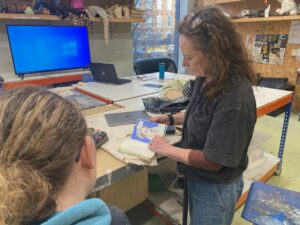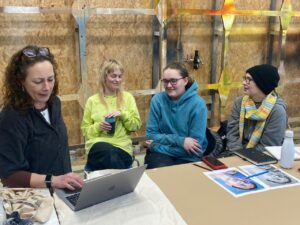In Conversation with Scenic Artist Sam Fellows
Sam Fellows has been a scenic artist for over 25 years, working across the theatre, film and television industries, as well as completing projects in the spheres of fashion, retail and events. Following her session with our Scenic Art and Prop Making students, we sat down with Sam to hear about her varied career, as well as her advice for those looking to break into the scenic art profession.
What inspired you to pursue scenic art as a career?

Sam has been working as a scenic artist for over 25 years
I grew up in a theatrical family and so spent a lot of time in theatres as a child, and I do remember loving seeing the scenery, both offstage and from the audience. I’d often hang out in the dressing rooms and then nip down in the interval to get an ice cream and watch the second act! Most members of my family are performers, but I was more into drawing and painting. After graduating with a Fine Art degree, I managed to get a job with an opera company, painting scenery, and I haven’t stopped!
How did you secure your first few professional credits?
It was so long ago, I honestly can’t remember how I got that first job in the workshop with the opera company. I do remember my first task though: cleaning and de-greasing the steel for the metalworkers! I guess I was helpful around the workshop so they kept me on and then asked me back. Every job seems to lead to other ones. That’s always my advice: don’t worry too much about your training and experience or how much you know or have done. Every painting job is different and when you start out, you’ll usually be shown how to do what is needed for that particular job. If you’re helpful, punctual, keen to join in and careful to follow what’s asked of you, you’ll be a valuable member of the team and you’ll be remembered when they need extra people again, or suggested to others when they need more people.
“If you’re helpful, punctual, keen to join in and careful to follow what’s asked of you… you’ll be remembered when they need extra people again.”
What are the common misconceptions about the work you do?
It’s surprising how many people aren’t aware of scenic art as a profession. I think many parents have traditionally steered children away from using their drawing and painting skills as a career, thinking it’s too hard to get into, too competitive and unstable. Although theatre has unfortunately taken a hit from Covid-19, the film and TV industries in the UK are booming. New film studios are opening up and they’re all busy with productions! I’ve also painted scenery many times for various other industries, such as fashion, retail and events. There’s a lot of work out there right now!
We hope you have had a good experience at Mountview in our studios. What was the main focus of your session while you were with the students?

Sam with Mountview’s Scenic Art and Prop Making students
I have had a brilliant time here at Mountview! Wow, what a vibrant space! I was hugely impressed by the set for The Addams Family in the Backstage Theatre. The student team, led by professional scenic artist Steven Peters, did an outstanding job and how excellent to get to paint for a professional designer on such a professional-looking production. So glad I got to sneak in and have a look. The session I was part of was large-scale portrait painting, where students gridded up a contemporary portrait onto large canvases on the paint frame. This involved practising their skills at draughting and gridding-up, at painting with large brushes and painting back cloths. Again, I’ve been hugely impressed by their skills, their work ethic and passion for painting!
What advice would you give someone thinking about training for a career in scenic art? Is training relevant and beneficial for an introduction to the industry?
Yes, I do think training is useful as a basis before going out there and securing work. It’s good to learn a variety of scenic art techniques and also to experience the whole process of painting a set, from first seeing the designer’s scaled model and references, through the initial sampling and then to the actual painting of the set, and finally seeing it on stage (or on set).
“I do think training is useful as a basis before going out there and securing work. It’s good to learn a variety of scenic art techniques and also to experience the whole process of painting a set.”
I’ve been working as a scenic artist for over 25 years now and although I do like to have a moan occasionally… it has been a rewarding career!
You can view Sam’s extensive work on her website.